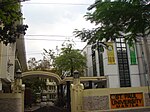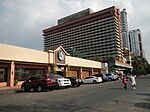Ramon Magsaysay Center
Buildings and structures in Malate, ManilaOffice buildings completed in 1967Skyscraper office buildings in Metro ManilaSkyscrapers in Manila

The Ramon Magsaysay Center (abbreviated as RMC or RM Center) is an 18-storey building located at the corner of Roxas Boulevard and Quintos Street in Malate, Manila, Philippines. It was built and opened in 1967 and was designed by Alfredo J. Luz and Associates, in consultation with Italian-American Pietro Belluschi and Alfred Yee Associates. It is named after Ramon Magsaysay, the 7th President of the Philippines who died in a plane crash in Cebu in 1957. It previously held the title as the tallest building in the Philippines from 1967 to 1968, before the completion of the Manila Pavilion Hotel.
Excerpt from the Wikipedia article Ramon Magsaysay Center (License: CC BY-SA 3.0, Authors, Images).Ramon Magsaysay Center
Manila Malate (Fifth District)
Geographical coordinates (GPS) Address Nearby Places Show on map
Geographical coordinates (GPS)
| Latitude | Longitude |
|---|---|
| N 14.5719 ° | E 120.9822 ° |
Address
1004 Manila, Malate (Fifth District)
Philippines
Open on Google Maps










